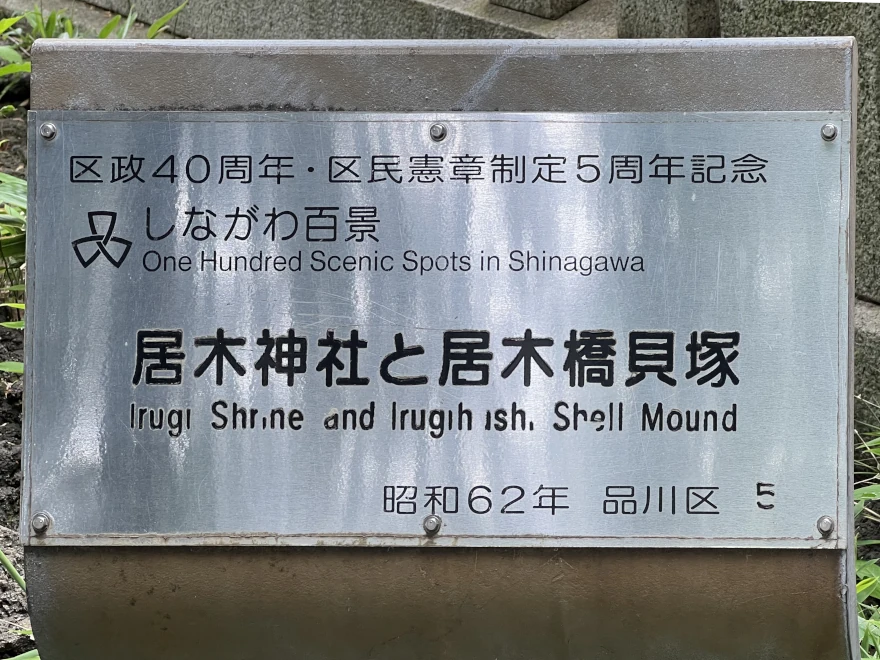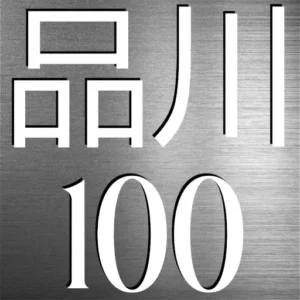⛩️ Irugi Shrine – Echoes from Prehistoric Shinagawa
Irugi Shrine (居木神社), nestled in Nishi-Gotanda, is a quiet but historically significant Shinto shrine. Adjacent to it lies the Irugihashi Shell Mound (居木橋貝塚), one of the archaeological remnants of Tokyo’s prehistoric Jōmon period. This area once looked out over Tokyo Bay, and the shell mound is evidence of ancient coastal settlements that relied on the sea for sustenance and ritual.
According to ancient records and a shrine noticeboard, the shrine was originally located near the present-day Irugibashi area in the former Ebara District of Musashi Province. At that time, it was called “Kiji-no-miya” (Shrine of the Pheasant), and a legendary tree known as the “Yurugi-no-Matsu” (Swaying Pine) grew within its sacred grounds.
⛩️Gosha Myojin – Five Deity Shrine
During the early Edo period, frequent flooding from the Meguro River led to the shrine’s relocation to its present elevated site. As part of this move, four smaller shrines—Kifune Myojin, Kasuga Myojin, Ko-Gongen, and Inari Myojin—were consolidated under one roof, and the newly combined site became known as “Gosha Myojin” (Five Deity Shrine). Irugi Shrine quickly became a bustling spiritual centre, hosting lively kagura performances and seasonal festivals. The Genroku Land Records describe Irugibashi Village at the time as prosperous, with 230 koku of rice production and a strong local devotion to the shrine.
Meiji Restoration – Renamed the Irugi Shrine
In 1872 (Meiji 5), the shrine adopted the name “Irugi Shrine” and was officially ranked as a village shrine. Further local shrines were merged into its precincts during the late 19th and early 20th centuries. A grand new main hall was constructed in 1933, only to be lost to wartime firebombing during the final stages of World War II. Thanks to the enduring devotion of parishioners, reconstruction began in 1977 and was completed with a formal relocation ceremony in 1978. Today, Irugi Shrine continues to serve as a symbol of resilience and community spirit in Osaki.
🌀 Irugihashi Shell Mound – Footprints of the Jomon People
Beneath the grounds of Irugi Shrine lies the Irugihashi Shell Mound, a precious archaeological site dating back to the early Jomon period. The mound represents the remains of an ancient community that flourished thousands of years ago along what was then the seashore. Layers of shells, animal bones, and pottery fragments unearthed here tell the story of a thriving settlement dependent on the rich bounty of rivers and tidal flats.Although much of the original shell mound has been buried by urban development, Irugi Shrine preserves the spirit of this ancient site. Visitors walking the high grounds of Irugi Forest are treading on history far older than Tokyo itself — a rare, hidden link to Japan’s deep prehistoric past.
🐚 The Shell Mound and Jōmon Life
Shell mounds like Irugihashi are formed from centuries of accumulated shells, bones, and other waste left by prehistoric communities. These archaeological deposits offer rich insight into early diets, rituals, and tool use. The Irugihashi mound contains layers of oyster and clam shells, as well as pottery fragments and fish bones.
It is believed that the coast during the Jōmon period reached as far inland as this site, making it part of a once-thriving seaside settlement. Though the mound itself is no longer visibly distinct, its discovery in the early 20th century brought attention to Shinagawa’s deep roots in Japan’s cultural evolution.
🏞️ Modern Recognition and Preservation
In recognition of the mound’s historical value, part of the surrounding parkland features interpretive signage detailing the shell mound’s discovery and significance. Educational plaques help connect modern visitors with the prehistoric past that lies beneath their feet. The combination of shrine and archaeological site makes this a unique cultural stop in Shinagawa Ward.
🌀 Shrine Details
- Main Deity: Yamato Takeru no Mikoto (日本武尊) — Heroic prince, deity of courage and travel
- Associated Deities: Takao Kami no Kami (高龗神), Ōkuninushi no Mikoto (大国主命), Kuraokami no Kami (倉稲魂命), Amenokoyane no Mikoto (天児屋根命), Sugawara no Michizane (菅丞相)
- Founding Era: Unknown, but pre-Edo relocation mentioned in early records
- Special Features: Edo-period torii and stone lanterns, Fujizuka mound, Irugihashi Shell Mound nearby
- Major Annual Festivals: New Year (Saitan-sai), Setsubun Festival, Summer Bon Dance, Reitaisai (late August)
Today, Irugi Shrine continues to serve as a quiet sanctuary amidst the busy Osaki skyline, hosting seasonal festivals that reflect deep local pride and history.
🧭 Visitor Information
Address: 5-6-3 Nishigotanda, Shinagawa-ku, Tokyo 141-0031
Access: 5-minute walk from Osaki Station (JR Yamanote Line, Saikyō Line, Shōnan–Shinjuku Line)
Best season: Spring (cherry blossoms) and Autumn (Reitaisai)
Admission: Free
Official Info: Irugi Shrine Official Website
Note: Be respectful during festivals and avoid loud noise on shrine grounds.
Where is it?
| what3words | ////fantastic.warriors.bottom |
| latitude longitude | 35.61983 139.72559 |
| Nearest station(s) | Osaki station (Yamanote Line, Saikyo Line, Shonan–Shinjuku Line, Rinkai Line) |
| Nearest public conveniences | Thinkpark |
Show me a sign.

This unassuming mound and shrine combo tells a far older story than most visitors realise. Look down — the ground holds layers of memory.
Withervee says…
If you’re craving something older than Edo castles, this is your stop.
It also has casts of Pikachu, Mickey Mouse and other characters normally protected by intellectual property rights.
Site Character
- Lifestyle 生活 (Seikatsu): ✔️
- Historical Significance 歴史 (Rekishi): ✔️
- Atmosphere/Natural Features 風土 (Fūdo): ✔️
Who in their right mind would vote for this?
- Local Shinto devotees
- Archaeology buffs
- Historical explorers
- Nature photographers
- Fujizuka enthusiasts
Further reading
While you’re there…
Explore the nearby Osaki Subcenter — a complete contrast of modern Tokyo skyscrapers rising over the Meguro River.

